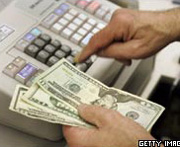|
 |
| High interest rates can take money out of
consumers' pockets |
The US Federal Reserve has raised rates by a quarter percentage point
to 2.25% - its fifth increase since June.
Encouraged by the country's
economic performance, the Fed's policy-makers voted unanimously for the
move.
Announcing the decision, the Fed added that future increases would
remain "at a pace that is likely to be measured".
The current round of rate increases began in June, when the central
bank ordered its first rise in four years, with rates at historic lows of
1%.
Extra-low rates had been used as a means to help
kick-start the economy after the 2001 recession
.
We doubt the Fed will even consider deviating from its current 25 base
points-per-meeting pace at least until Fed funds reach 3.0%
Furthermore, US industrial output figures released just before the
Fed's latest meeting showed US output is continuing to improve.
Analysts say the latest rates increase comes as a recovery in the US
economy, the world's biggest, shows signs of robustness and
sustainability.
Between July and September the economy grew at an
annual rate of 3.7%, recent retail sales figures showed a surprise upsurge
and employment
continues to recover with 112,000 jobs added to the market in November.
In a statement, the Fed added the economy "appears to be growing at a
moderate pace, despite the earlier rise in energy prices, and labour
market conditions continue to improve gradually".
Many pundits remain undecided about where the Fed will go at its next
rate-setting meeting in February, with some claiming the use of the phrase
"measured pace" signals more hikes ahead.
"I think the Fed believes the economy is on cruise control right now,
boosted by accommodative monetary policy, and that it still sees the need
to move interest rates closer to neutral levels," said BMO Financial Group
senior economist Sal Guatieri.
However, inflation risks - such as rising consumer prices and wage
costs - could force the central bank into an increase sooner rather than
later.
But the Fed shrugged off any inflation worries saying inflation and
longer-term inflation expectations remained "well contained".
Since it began its cycle of tightening, the Fed has raised rates by
quarter point increments at each time.
Most experts now expect US borrowing costs to hit between
3.5% and 5% next year.
(Agencies) | 